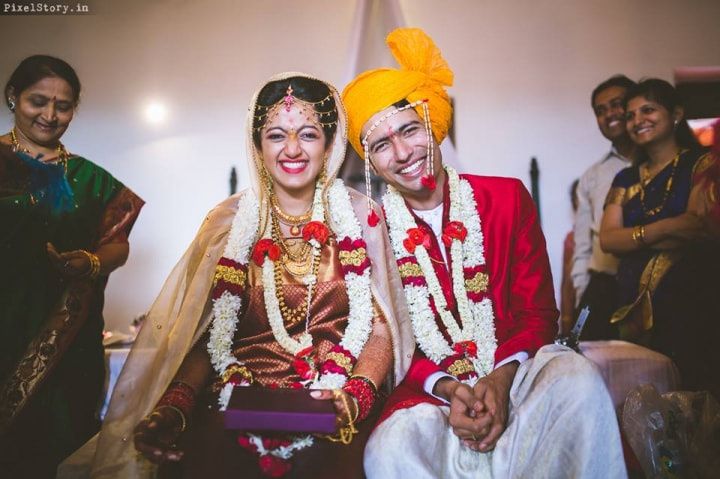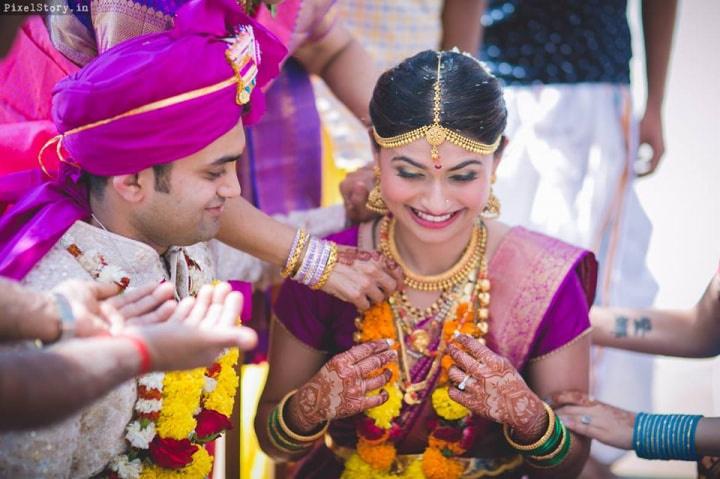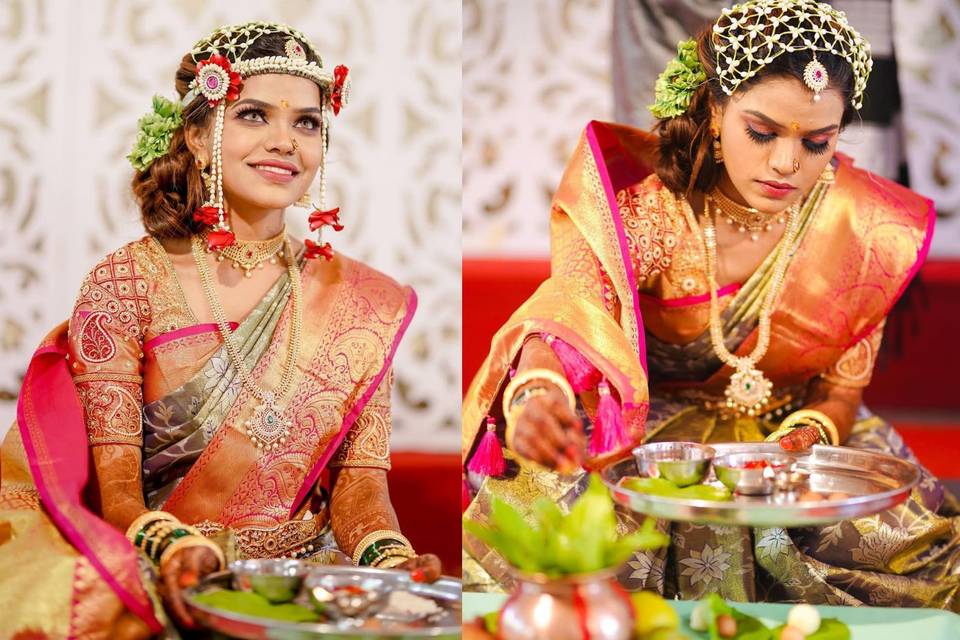10 Lingayat Community Wedding Traditions That Make It So Special
The typical Lingayat community wedding has it all. Right from the Nishchay Tamulam — engagement ceremony — to the Gruhapravesham. Learn about it here.


If you, the soon-to-be newly married couple, hail from the Lingayat community brace yourselves. Your wedding ceremony is bound to be an extravaganza of tradition and a time for friends and relatives to bond. A typical Lingayat community wedding starts with an engagement ceremony and ends with a reception and in the in-betweens are all about meaningful ceremonies.
1. The Nishchay Tamulam

The traditional engagement ceremony for this community sees the bride partaking of coconuts, sweets and a traditional wedding ceremony saree from the groom’s family.
More conservative Veer Shaivites or Lingayats are strict about the matching of horoscopes. If the horoscopes predict a fateful union — a mere formality — the exchange of gifts proceeds. In fact, horoscope matches, as done with the Lingayat community, are also seen in many other traditional wedding ceremonies - from the Marathi wedding ceremonies to the Tamil wedding rituals.
The groom doesn’t leave empty-handed, having accepted sweets and a wedding dhoti from the bride’s side of the family. The wedding date is fixed amid brouhaha and the celebratory phase follows.
This Lingayat community tradition is the first tradition that starts the wedding ceremony.
2. The first phase
No Lingayat community wedding ceremony is complete without a Pooja to have a smooth celebration. If you, the couple are wary of tradition, worry not — this is when the fun begins. The Nandi Pooja, as it is called, is an event for the bride and groom to show their devotion to each other and to Lord Shiva, the Lingayat community’s deity.
The ceremony is the first phase, marking the start of wedding photography with near and dear ones. All bedecked, this is when the couple plunges into the celebratory phase.
3. A make-believe trip

The Kashi Yatra is a time for relatives and friends of the couple to regale themselves. It's role-playing time for the Lingayat community groom — he pretends like he has not found a suitable bride and will take a pilgrimage to Kashi. The bride’s uncle then shows a photograph of her to the groom, convincing him to stay back. Filled with jokes, the ceremony is nevertheless marked by traditional South Indian food and is a kick-off for the actual marriage ceremony.
This is followed by another Pooja, in which everything to be used for the wedding ceremony is placed before an idol of Lord Ganesha and a ritual follows. Relatives rub haldi on the couple. The entire ritual is called Dev Karya.
4. The attire
The couple is adorned with the rich, traditional attire of the Lingayat community. The attire is usually silk — a saree for the bride and a Veshti and kurta for the groom. Adorned with traditional jewellery, you, the couple, are prepared by relatives and friends to star in this milestone in your lives. The makeup is subtle and as per the needs of the wedding photographer.
5. Mandap Pooja and Var Pooja

The Lingayat community is known to be traditional. The wedding ceremony is kick-started by a Pooja to spiritually cleanse the spot of the ceremony. Called the Mandap Pooja, this is presided over by the official priest for the wedding.
Traditionally, this ritual is looked upon as a purification ceremony to maintain piety during the ceremony. After this follows another ritual called the Var Pooja, in which the groom’s soon-to-be father-in-law washes his feet. The bride’s father performs an aarti before the groom and applies tilak.
6. The main ritual
The groom awaits the bride at the mandap and after the bride, escorted by her uncle arrives - the actual wedding takes place. Separated by a white cloth, the couple is anxious to take a peek at each other. Imagine the feeling of happiness and anticipation while both the bride and groom wait to lay their eyes on each other!
The priest recites holy mantras to sanctify the Lingayat community wedding ceremony. Soon, relatives remove the white cloud and the couple immediately garlands each other amid a wave of smiles.
7. “We vow to…”

The couple exchange holy ritual marriage vows and the groom’s Angavastram is tied to the bride’s saree. The couple circles the holy ritual fire seven times reciting the seven special sacred mantras. The groom then holds a Lingayat Mangalsutra around the bride’s neck, which is tied by five married women themselves adorned with Mangalsutra.
8. Dhara Hardu
The guests feast after a tiresome and eventful wedding ceremony, and it’s time for the bride to take leave. This is called the Kanyadaan; it is marked by the father of the bride, who places the bride’s right hand in the groom’ right hand. Shedding tears, it’s time for the emotional bride to take flight from her parent’s abode.
A traditional Lingayat Kanyadaan is called Dhara Hardu. The bride’s father sees the couple off with a gift of coconut and betel leaves. The gift is purified with a splash of holy water.
9. Here comes the bride

Called Gruhapravesham, the bride enters the groom’s house for the first time after the wedding ceremony. His mother performs an Aarti, after which the bride kicks a copper pot filled with rice with her feet, marking her entry. This symbolises prosperity is bound to enter into the lives of the couple.
The following day is marked by a visit by the couple to the bride’s abode where they sojourn for a day and the bride’s family rejoices at her return and feasts, making merry.
10. All’s well that ends well
After a day’s stay, the groom’s family holds a reception to introduce the bride to its friends and relatives. This can be an elborate wedding reception, replete with a separate venue, guest list and a large catering spread. It could also be a feast at home for the near and dear ones, depending on the inclination of the couple and their families.
It may seem that the typical Lingayat community wedding reeks of customs and rituals, but it is actually a time of symbolic bonding as families come together to celebrate a new beginning. These simple customs showcase how the Lingayat community maintains a strong bond with its own ethos and still accommodates the visions of a new-age couple.
How was your experience witnessing these traditions?











